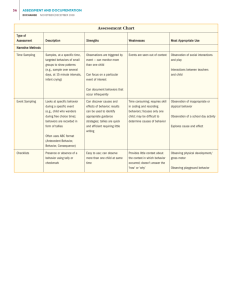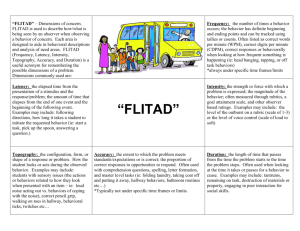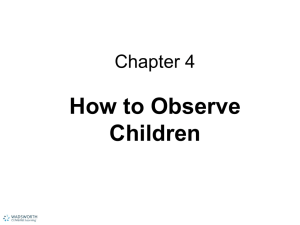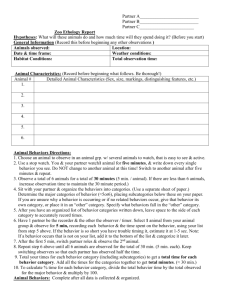SYSTEMATIC OBSERVATION
advertisement
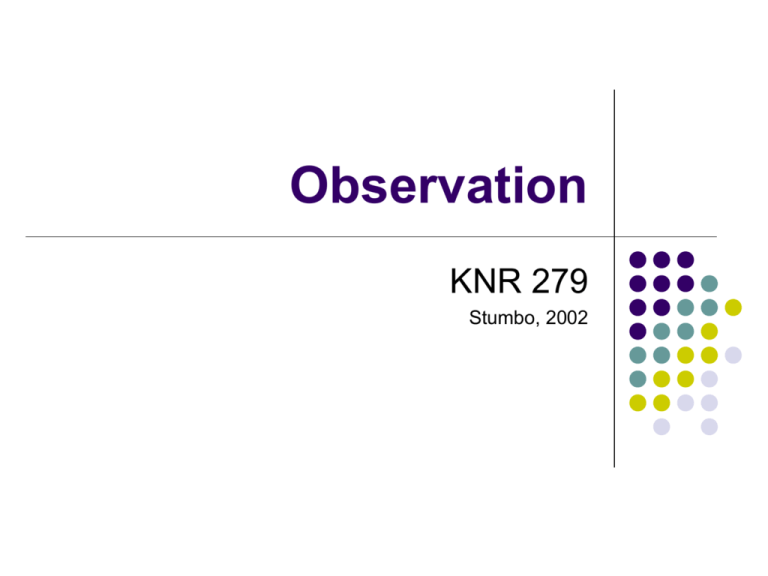
Observation KNR 279 Stumbo, 2002 Observation as Assessment Therapist observes client’s behaviors Directly Indirectly Primary reason is to record behavior Not perceptions/thoughts/feelings/motives like in interview Looks at behavior in as real life situations as possible Typically uses recording systems to shorten time recording observations Advantages? Disadvantages? ADVANTAGES Record behaviors that occur naturally in the environment Generalize behaviors to community Can be used with children or others with verbal or thought processing problems DISADVANTAGES Cost in staff time Fitting observer unobtrusively into setting Potential subjectivity or bias of observer Determining meaningful behaviors to observe Inability to determine meaning Systematic Observation Differs from casual observation Has a specific purpose Collect data about clients Targets certain behaviors Records behaviors systematically Has concerns of reliability & validity USE SYSTEMATIC OBSERVATION TO: Document typical client performance or behavior Document unusual behavior Confirm results of another assessment Triangulation Compare clients’ behaviors Steps to Developing Systematic Observations Determine sample behavior that is important to observe Determine procedures for collecting, organizing, & analyzing data Who, where, for how long, under what circumstances, how many occasions Record behavior immediately to minimize dependence on memory & preserve detail of behavior Determine conditions under which behavior will be observed Natural (e.g., community outing) or contrived Obtrusive or unobtrusive Mechanical (e.g., videotape) or human Steps to Developing Systematic Observations Determine data collection instrument Recording methods Recording techniques Pilot test Reliability Validity Protocol Train staff as observers OBSERVATIONAL RECORDING METHODS Checklists Rating scales Anecdotal records Critical incident reports CHECKLISTS Record if present or absent Useful to assess mastery of concrete learning tasks Leave little room for interpretations Easy to administer, score, interpret Inter-rater reliability tends to be high Difficult to define behaviors RATING SCALE Similar to checklists, but can indicate degree Fairly easy to administer and score if wellconstructed Hard to construct Personal biases enter into rating Between 4-6 points should be provided ANECDOTAL RECORDS Provide snapshots of actual behavior in natural situations that are significant indicator of total behavior Allows recording of environment, antecedents, and consequences of behaviors Allow recording in non-standardized form Can be time consuming Hard to be objective ANECDOTAL RECORDS cont. Difficulty in deciding level of detail to record Inconsistent wording used Difficulty collating and analyzing Determine in advance what to observe, but be alert for unusual behavior Develop procedures for coding Train observers Critical Incident Reports Differ from anecdotal records Used to record unusual situations/behaviors Recording antecedents, behavior, and consequences is required Factual information kept separate from interpretation Often used in SRAs for behavior management plans See Stumbo, 2002, p. 229 OBSERVATION RECORDING TECHNIQUES Frequency/tally Duration Interval Instantaneous time sampling Frequency/Tally Records number of times a behavior occurs Behavior needs to be clearly defined Need to determine if behaviors are significant enough to observe Can use if observe more than one person at a time See Stumbo, 2002, p. 230 Duration Used when length of behavior is important Stop watch can be used Behaviors must be clearly defined & observable for a period of time See Stumbo, 2002, p. 231 Interval Focuses on frequency and duration of behaviors Determine size of intervals on basis of how often the behavior occurs If behavior occurs in interval, mark is recorded Stumbo, 2002, p. 232 Instantaneous Time Sampling Used when observer enters & exits observation area periodically Observer does not have time for lengthy observation Many individuals can be observed at once Patterns of behavior is important Look for absence or presence of behavior See Stumbo, 2002, p. 233
